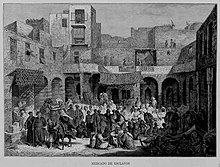This article needs additional citations for verification. |
| Part of a series on |
| Forced labour and slavery |
|---|
 |





Slavery in Egypt existed up until the early 20th century. It differed from the previous slavery in ancient Egypt, being managed in accordance with Islamic law from the conquest of the Caliphate in the 7th century until the practice stopped in the early 20th-century, having been gradually phased out when the slave trade was banned in the late 19th century.
During the Islamic history of Egypt, slavery were mainly focused on three categories: male slaves used for soldiers and bureaucrats, female slaves used for sexual slavery as concubines, and female slaves and eunuchs used for domestic service in harems and private households. At the end of the period, there were a growing agricultural slavery. The people enslaved in Egypt during Islamic times mostly came from Europe and Caucasus (which were referred to as "white"), or from the Sudan and Africa South of the Sahara through the Trans-Saharan slave trade (which were referred to as "black"). British pressure led to the abolishment of slave trade successively between 1877 and 1884. Slavery itself was not abolished, but it gradually died out after the abolition of the slave trade, since no new slaves could be legally acquired, and existing slaves were given the right to apply for freedom. Existing slaves were noted as late as the 1930s.
To this day, Egypt remains a source, transit, and destination country for human trafficking, particularly forced labor and forced prostitution (cf. human trafficking in Egypt).